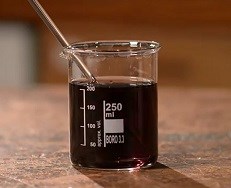Iodine Clock Reaction
Iodine Clock Reaction

Try an at home version of this experiment using a few things you may have in your bathroom medicine cabinet. In may ways this experiment feels almost like magic. Two colorless liquids are mixed together and after a few moments the mixture turns a dark blue color. There are actually a couple of simple chemical reactions going on at the same time to make this “clock reaction” occur. This version of the classic “iodine clock reaction” uses safe household chemicals most people have on hand at home.
What you need:
- distilled water (tap water will work OK as well)
- a couple plastic cups
- 1000 mg vitamin C tablets
- tincture of iodine (2%)
- hydrogen peroxide (3%)
- liquid laundry starch
What to do:
- Make a vitamin C solution by crushing a 1000 mg vitamin C tablet and dissolving it in 2 oz of water. Label this as “vitamin C stock solution”.
- Combine 1 tsp of the vitamin C stock solution with 1 tsp of iodine and 2 oz of water. Label this “solution A”.
- Prepare “solution B” by adding 2 oz of water to 3 tsp of hydrogen peroxide and 1/2 tsp of liquid starch solution.
- Pour solution A into solution B, and pour the resulting solution back into the empty cup to mix them thoroughly. Keep pouring the liquid back and fourth between the cups.
What’s going on?
There are actually two chemical reactions going on at the same time when you combine the solutions. During these reactions two forms of iodine created – the elemental form and the ion form.
In Reaction # 1 iodide ions react with hydrogen peroxide to produce iodine element which is blue in the presence of starch. BUT, before that can actually happen, the Vitamin C quickly reacts and consumes the elemental iodine.
The net result, at least for part of the time is that the solution remains colorless with excess of iodide ions being present. Now after a short time as the reactions keep proceeding in this fashion, the Vitamin C gets gradually used up. Once the Vitamin C is used up, the solution turns blue, because now the iodine element and starch are present.
Safety Precautions
Be careful when working with the iodine – it stains, and it stains really well. Be very careful not to spill any of the solution.
Waste Disposal
Dispose all liquids down the drain with plenty of water.Learn More
Dig deeper into the science behind clock reactions in this paper from the Journal of Chemical Education.
